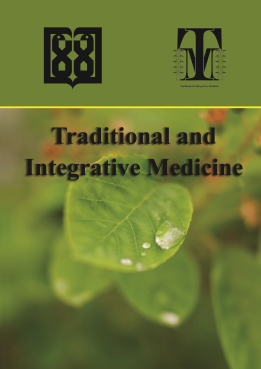A Review on the Structure and Function of Liver from Avicenna Point of View and Its Comparison with Conventional Medicine
Abstract
Persian medicine (PM) scholars have explained the structure and function of each organ based on clinical observations and past experiences. The liver is one of the three commanders in the body (brain, heart, liver) that manages nutrition and growth. This study was aimed to evaluate the anatomy and physiology of the Liver as presented in PM school and compare with conventional medicine. Relevant keywords were searched through PM reference books, Google scholar, PubMed, Web of Science and Scopus. After extracting the data, the results were classified in terms of concepts and categories. PM scholars believe that liver is one of the first organs created in the fetal period. In their view, the liver has a warm and wet temperament. In this manner the natural blood’s temperament is warm and wet and it arises from the temperance of the liver and its correct function. In conventional medicine, the Liver consists an operational unit called hepatic lobule and plays an important role in the metabolism of the nutrition’s and growth of tissues. Overview of fetal origin, structure and function of the liver between these two schools of medicine interpreted in many ways, revealed many similarities. Thus, we can utilize PM's point of view on the liver and its important functions in the body, especially in the field of disease prevention and treatment.
Elgood C. Iran Medical History and the Regions of Eastern Caliphate. AmirKabir. Tehran 1992; p 19.
Aciduman A, Er U, Belen D. Peripheral nerve disorders and treatment strategies according to Avicenna in his medical treatise, Canon of medicine. Neurosurgery 2009;64:172-178.
Fauci AS. Harrison's principles of internal medicine. 17th ed. McGraw-Hill. New York 2008; pp 64-70.
Bahrami M, Farahani RM, Nazem E, Kamalinejad M, Keshavarz M, Nasrabadi AN. The Body Organs and Their Reconstruction Power (Regeneration) From the Viewpoint of Iranian-Islamic Physicians. Iran Red Crescent Med J 2014;16:e15193.
Khadem E, Toosi MN, Ilkhani R. Liver-Heart Inter-Relationship in Fatty Liver Disease Based on the Avicenna's Point of View. Iran J Public Health 2013;42:648-649.
Toosi MN, Ardekani MRS, Minaie MB, Nazim I, Esfahani MM, Khadem E. Fatty liver disease from the perspective of traditional Iranian medicine. Quran and Med 2012;1:117-118.
Avicenna. The canon of medicine. Vol 1. Institute Dare Ehya al-Toras. Beirut 2005; pp 26-29, 39-44,80,89-91,151.
Aghili Shirazi MH. Kholase al hekmah. Vol 1. Esmailian. Quom 2006. pp 57,255-257,329.
Tabari A. Ferdows al-hekmah fi al-tibb (Paradise of wisdom on medicine). Aftab Press. Berlin 192; pp 36-38,40,45,63,65
Ebne-elyase Shirazi MM. Tashrihol-Abdan. Majma zakhayer eslami. Quom 2002; pp 51-59,126-129,169.
Heravi M. Bahr al-Jawaher. Jalaluddin Publications. Qom 2008; 118.
Vajed A. Elm al-Abdan. Lucknow: Monshi Luckenshow. 1889; p 5.
Azodi AM. Kitab Al-Ma'. Iran University of Medical Sciences, Institute of Medicine History, Islamic and Alternative Medicine. Tehran 2009; p 260.
Jorjani EI. Al-Aghraz al-Tebbiah va Mabahes al-Alajiah. Bonyad-e Farhang-e Iran. Tehran
Ahvazi AEA. Kamil al-Sinaā al Tibbiya. Jallaleddin. Qom 2008; Vol 1 pp 73-75,123,319-320, 192-194, Vol 2 p 101. [InArabic].
Razi MZ. Al-mansoori fi teb. Institute AL-monazamat - Arabiato-tarbbiato va safaghate val Oloom. Koveit 1986. p 33-34,52,68-69,87.
Azam Khan M. Exir Azam [Persian]. Vol 3. Institute of Meical History, Islamic Medicine and Complementary Medicine. Tehran 2008. p 2.
Vaghasloo MA, Naghizadeh A, Keshavarz M. The Concept of Pulse. Trad Integr Med 2017;2:54-60.
Vaghasloo MA, Naghizadeh A, Babashahi N. The Concept of the Haar-re-Gharizi and Hararate Gharizi: The Innate Hot [Substance] and Heat. Trad Integr Med 2017;2:3-8.
Shirbeigi L, Zarei A, Naghizadeh A, Vaghasloo MA. The Concept of Temperaments in Traditional Persian Medicine. Trad Integr Med 2017;2:143-156.
Sadler TW. Langman's Medical Embryology. Lippincott Williams & Wilkins, a Wolters Kluwer business. 13th ed. Philadelphia 2015. pp 217-218.
Juza RM, Pauli EM. Clinical and surgical anatomy of the liver: a review for clinicians. Clini anatomy 2014;27:764-769.
Mescher AL. Junqueira’sBasic Histology. 13th ed. McGraw-Hill Education 2013. pp 329-339.
Hall J. Guyton and Hall textbook of medical physiology. 13th ed. Elsevier. Philadelphia 2016. pp 881-886.
Sendensky A, Dufour J-F. Liver physiology. Chronic Liver Failure: Springer. 2011:33-45.
Volle DH. Bile acids, roles in integrative physiology and pathophysiology. Mol Aspects Med. 2017;56:1.
Senoo H. Structure and function of hepatic stellate cells. Med Electron Microsc. 2004;37:3-15.
Abshagen K, Kuhla A, Genz B, Vollmar B. Anatomy and physiology of the hepatic circulation. PanVascu Med. 2013:1-28.
Naito M, Hasegawa G, Ebe Y, Yamamoto T. Differentiation and function of Kupffer cells. Med Electron Microsc. 2004;37:16-28.
Fadaei F, khadem E. A review on the structure and function of the skin in Iranian traditional medicine point of view and comparison with conventional medicine. J Dermat Cosmet 2017;8:48-56.
Lim Y-S, Kim WR. The global impact of hepatic fibrosis and end-stage liver disease. Clin Liver Dis 2008;12:733-746.
Nguyen P, Leray V, Diez M, Serisier S, Bloc’h JL, Siliart B. Liver lipid metabolism. J Anim Physiol Anim Nutr 2008;92:272-283.
| Files | ||
| Issue | Vol 4, No 1, 2019 | |
| Section | Review Article(s) | |
| DOI | https://doi.org/10.18502/tim.v4i1.1666 | |
| Keywords | ||
| Liver; Persian medicine; Avicenna; Iranian traditional medicine | ||
| Rights and permissions | |

|
This work is licensed under a Creative Commons Attribution-NonCommercial 4.0 International License. |




